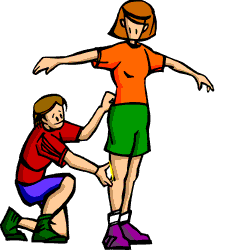|
Outcome
B (4-6)-3
 |
3.
Get Bent! (Stay Flexed)- Outcome B (4-6)-3
(Flexibility) |
The
purpose of this activity is to enable students to define flexibility,
perform a number of stretching exercises, and state the benefits
of good flexibility.
Start the class with
a discussion about the definition of flexibility, joints, and movement.
 |
|
Flexibility
Demonstration:
Use
a large rubber band, and ask a student to help you. Hold the
rubber band at the student's waist (on the back), then stretch
the band to the student's knee (along the back of the leg).
Ask the students to touch their knees, allowing the rubber
bands to stretch as the students do. Next ask the students
to touch their toes, and again allow the bands to stretch
with them.
Use the rubber band to explain to the students how far muscles
have to stretch to achieve movement, and how important flexibility
(the ability to stretch) is to movement.
|
Measuring
Flexibility: Pair the students up and have them measure each other's
flexibility using a floor stretch and chalk. Use the lines on the
gym floor as a guide. Each student places their heels on a line,
and keeping their feet flexed and legs straight, they reach out
with straight arms over their legs as far as they can. They must
hold the stretch for 15 seconds without bouncing, and mark the point
they reached with chalk.
The
True Test: One student will be the exerciser, the other will be
the non-exerciser. The non-exercisers get to relax while the exercisers
go through a series of flexibility exercises. Each stretch must
be held for 15 seconds without bouncing.
Crossover
hang
Sit and reach
Straddle right, left and centre
Hang time
Now, have the entire
class repeat the flexibility measure. The non-exercisers should
show no improvement, while the exercisers should show some improvement
over the first measurement taken, in the distance they can stretch.
 |
Why did the exercisers
improve their reach? How could this help someone who is playing
sports or participating in physical activities?
|
Talk
about the "use it or lose it" principle. The benefits of doing stretching
exercises are short-term unless a person continues stretching on
a regular basis. Explain that lower back pain is a common problem
in adults (ask the students to go home and measure their parents
flexibility using the same test). Many adults don't exercise frequently
so their muscles become weaker and less flexible. That makes them
more likely to be sore or stiff. If you don't want to be less mobile
when you are older, it is a good idea to "Do it Daily" - physical
activity and stretching.
The preceding three activities
each deal with a separate component of fitness. At the end of this
section, help students make the connection that all of the components
work together to increase their level of functional fitness.
back
to top
|


